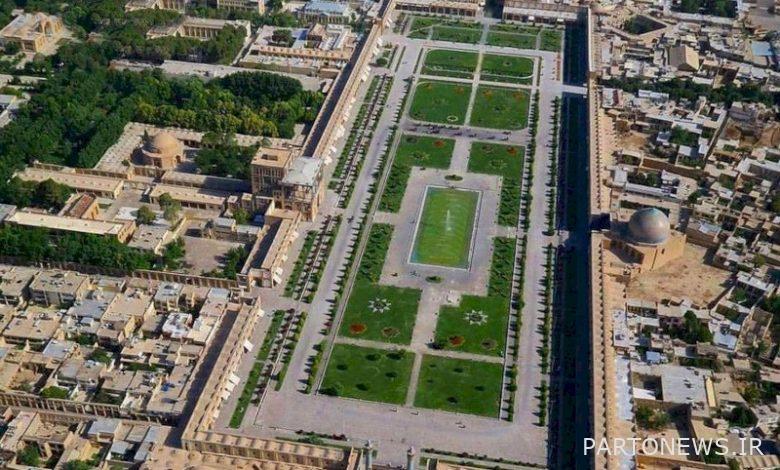Aali Qapo Palace, a symbol of cultural tourism in the half of the world

Today, countless groups of experts, thinkers, orientalists and Iranologists believe that half of the known beauties and charms of the universe have been identified in this region and for this purpose it has been called half of the world.
In pursuit of recognizing this identity, the Safavid era can be considered the peak of the formation of the glory of Isfahan. Therefore, after Isfahan was chosen as the capital of the Safavid dynasty, Shah Abbas ordered the great architects of that time to build a unique royal residence in an area of Isfahan to show his greatness and power to other rulers, which was called the Safavid state. This place is unique in terms of size and grandeur, as well as in terms of architecture and beauty. Although the life of Shah Abbas was not enough to see the whole complex, but during successive years and by the Safavid kings, this government expanded day by day.
The headquarters of the city of Isfahan in the Safavid era was located on the western side of Naqsh Jahan Square to Chaharbagh Street and included palaces, mansions, halls and magnificent gardens. Isfahan was the third and last Safavid capital after Tabriz and Qazvin, which became one of the most beautiful and glorious cities of that time, about 150 years after Shah Abbas I came to power.
Familiarity with Isfahan and its shining jewel, Naghsh Jahan Square (center and heart of the city) Familiarity with a corner of the rich cultural heritage of this land. The peak of the greatness of the Safavid era can be seen in the unique complex of Naghsh Jahan Square, the center of the new capital of the Shah Abbas Foundation.
Mobarakeh Government The role of the world or the mansion of Aali Qapo
The building of Aliaqapo Palace was built by the order of Shah Abbas Safavid, then the expansion and decoration of this mansion continued during the reign of Shah Abbas II and Shah Sultan Hussein. This palace is a wider example of the High Palace of Qazvin and was built on the western side of Naqsh Jahan Square after the change of the Safavid capital by Shah Abbas I from Qazvin to Isfahan.
Aali-Qapo mansion is built on the west side of Naghsh-e Jahan Square with an infrastructure of about 1800 square meters and six floors. The salient features of this palace include the beautiful decorations of the floors, the sound reflection at the entrance of the palace, the very beautiful reception hall and the main music hall. The palace has 53 rooms for relaxation, meetings, government and reception of ambassadors and guests. The basis of the body of the Mobarakeh Naqsh-e Jahan government is based on wooden foundations. Aali Qapo Palace (original name Ala Qapi) is one of the most beautiful examples of Safavid architecture, which is actually located at the entrance of the Safavid state and at first had a simple shape and over time and during the reign of Shah Abbas, a class was added to it and during the reign of Shah Abbas The second pillar porch was added to it. This building is located in front of Sheikh Lotfollah Mosque. Its height is 34 meters, which can be reached to the upper floors by spiral staircases.
Aliaqapo has six floors, each of which has its own decorations, and although after the Safavid period, the decorations were damaged and irreparable damage was done, nevertheless, it still contains masterpieces of bedding and paintings of the Safavid era, and tourists admire and admire Praise be to God. What has made Aali Qapo one of the most magnificent and exquisite works of the Safavid era are the miniature paintings by the famous Safavid artist Reza Abbasi, as well as the bedspreads on the top floor of Aali Qapo Palace, whose hall is a “music room” or “sound room”. It is also called.
Shah Abbas II watched the games and various events in Naqsh-e-Jahan Square from Aali-e-Qapo porch. He also dealt with the affairs of the country in Al-Aqapo and issued the necessary orders.
Western entrances of Imam Square (Naghsh Jahan)
Unlike the eastern, northern fronts and the gates of the square, which connected the complex with the residential and public areas of the city, in the western part of the square, there were gates and entrances that were government entrances for courtiers and government officials and the king himself. It counted. These entrances were created to the west of the square, making it possible to connect the square with the buildings, government districts, and royal campuses created to the west of the square. Aliaqapo Palace, Pearl Palace, Chehelston Palace, Chahar Houz Square and the Harem complex were considered as part of this governmental area, in other words, the Safavid state. One of the most important of these accesses to the government was the passage through the gate at the foot of the Aliaqapo Palace, which was dedicated to the Shah and his entourage. In other words, the passage and corridor located in the western axis of Aliaqapo Palace was the most important entrance of Naqsh Jahan Square to the Safavid state in the west of the square.
The entrance of Aliaqapo Palace in Naghsh Jahan Square was of great importance in the past due to its use. In the past, this entrance was the place of travel and the connection axis between Naqsh-e Jahan Garden and complexes and buildings such as Government House, Rakibkhaneh, Jabehkhaneh, Timurid Hall, Tavileh Hall, Indoor Hall, Chehelston Palace and other administrative buildings and palaces. It was called the “Government Gate”.
In fact, Aali Qapo Palace has five different entrances. Due to its beauty and fame, the main entrance of this mansion is mostly in Naqsh-e Jahan Square, but the other four doors, especially in the past, have been used as a means of transportation. The other entrances are called Aliaqapo, the door of the four pools on the north side of the palace, the royal door overlooking the city gate or the government gate to the west of the mansion, the door of the shrine and the door of the front house or kitchen.
Ali Qapo Palace was called the symbol and headquarters of the “world of power”. The Safavid king settled in this palace and watched the social life of the people in the square. The presence of this building in the square, whose porch, unlike the other building, which sits behind the quadrangular geometry of the square, has penetrated the square. Makes the world of power more symbolic. On the other side of Aliaqapo (the world of power) stands the mosque of Sheikh Lotfatullah (science). During the Timurid period, during the transfer of the Iranian capital from Qazvin to Isfahan and before it became the palace of Aali Qapo, it was chosen as the solution for the affairs of the country and the king’s court and government affairs, but gradually changed to the beautiful and interesting palace of Aali Qapo. Was converted.
Aliaqapo Palace is a building built during the reign of Shah Abbas I, which was built in the first half of the 11th century AH and was the meeting place of the affairs of the country and the court of the king. Contemporary historians with Shah Abbas I have called it (the Holy House of Naqsh-e Jahan). The foundation of this mansion was built during the reign of Timur’s successors, but Shah Abbas I added five more floors in 1018 AH. The date of the beginning of the construction of Aali Qapo Palace and the time of its completion are not known, but the available evidence suggests that this mansion and the building in front of it (Sheikh Lotfallah Mosque) was completed at a close time in the 11th century AH while building the Shah Mosque. These two royal buildings, one of which was the Shah’s palace and the other the mosque for the royal family, have been completed.
The name Aali Qapo is an imitation of two words (Bab Aali) and the palace of the Ottoman Sultan in Istanbul, and Shah Abbas intended to draw the attention of European politicians to this palace of the same name in Iran. Give. The stability of the Aliaqapo Gate was considered a symbol of the political meaning of this great palace, and the presence of the royal spectators, coronation ceremonies, group introductions and general ambassadors, all of which took place in front of the porch and was visible to all, reflected the political moments of that glorious palace. have been.
The words excellent (tall, lofty, noble and transcendent) and qapu (door, gate) are read, so high qapo (high gate or transcendent gate) is a Turkish word. Some believe that the name of this gate is named after Imam Ali (AS), the son-in-law of Prophet Mohammad (PBUH), and others believe that it means God and called it the gate of God. The government house had six doors and was not just an entrance, but also a safe haven for meetings and court meetings. The palace, like the houses and mansions of the nobility, had a smaller gate (the door of the square government) that was built to accommodate daily commutes nearby.
Aliaqapo Palace has six floors and from its seventh floor, which is the roof of the mansion, the best view of the ancient city of Isfahan emerges. Important personalities always gathered on the upper ground floor before entering the upstairs hall. Government workers in this class also maintained equipment for court meetings and celebrations. As the gate in the mansions of the nobles and merchants reveals the wealth and connection of its inhabitants, Aliaqapo emphasized the political role of the Safavid king. The majestic gate of the palace came out of the square and, breaking the facade, showed itself as a prominent mansion. From this columned hall, the king supervised the daily views of the square.
The sixth floor of this mansion was a place for the official receptions of the king and the gathering of musicians, builders and musicians. The largest hall of the Aliaqapo mansion is on this floor, and its type of decoration on the ceilings is plasterwork that is installed in the arches and walls and their corners, and it is a kind of Iranian art, and this floor is known to the people as the sound and music room.
Aali Qapo is a symbol of Isfahan cultural tourism
One of the most important factors in cultural attractions is the Safavid dynasty in Isfahan.
Naghsh Jahan Square is one of the most valuable architectural complexes in post-Islamic Iran, which in terms of beauty and grandeur can be compared with the pre-Islamic Persepolis complex. The unity and glory of Naqsh-e Jahan Square is not only approved by Iranians but also by many people around the world, tourists and Orientalists who have visited this square during different historical periods. The architectural space is arranged in such a way as to evoke the most appropriate feelings in the pedestrian. This square is a unique architectural phenomenon in the world of art in terms of its size and also in terms of composition and historical-cultural monuments around it.
Today, access to souvenir and handicraft sales centers, as well as health services and a variety of restaurants, as well as a bus station and a variety of public transport vehicles and other attractions, has made Aliaqapo Palace one of the most important tourist destinations in Isfahan, especially for tourists. Tourists in this area can easily travel from the city of Isfahan and while visiting historical and cultural attractions such as Aali Ghapo, they can enjoy other attractions related to the tourism industry such as souvenir supply centers and authentic handicrafts of Isfahan along with access to various reception centers in the Grand Square complex. .
.

